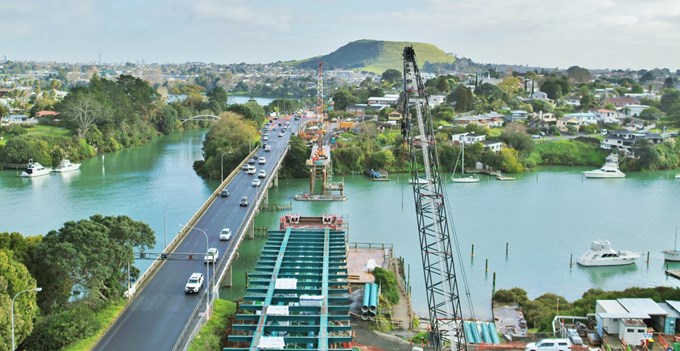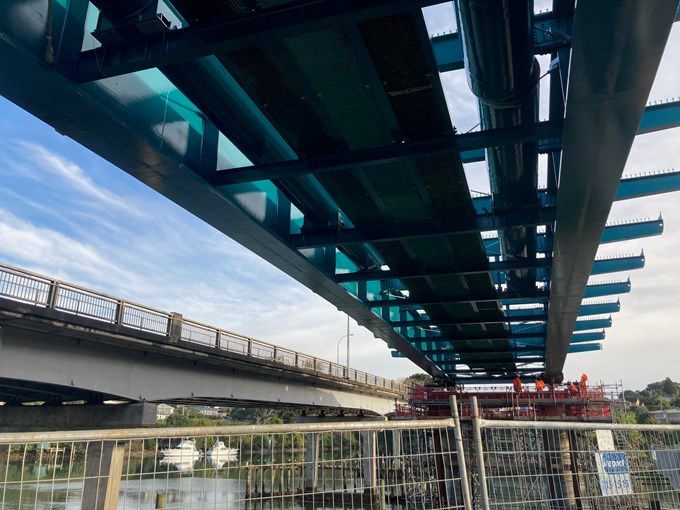In a first for New Zealand, a new bridge is being slowly pushed across the Tamaki River as part of the $1.4b Eastern Busway.
There are four spans and each one is connected to the section behind it. Each launch of the bridge is around 50 metres and takes up to ten days to inch across the river.
Mayor Phil Goff says this construction method is a first for New Zealand and speeds up the assembly.
“The first of the steel bridge spans were delivered to the construction site earlier in the year and are the largest single steel spans ever to be fabricated in New Zealand.
“The new busway bridge is more than 200 metres in length and contains 1,000 tonnes of steel and 2,000 tonnes of concrete,” says Mayor Phil Goff.
“It’s a feat of engineering and will be an integral part of the completed busway, supporting high-frequency bus travel between Panmure and Pakuranga and eventually Botany once the full project is completed in 2025.
“Thanks to funding provided through the Regional Fuel Tax, this project will transform east Auckland and deliver the transport infrastructure needed to accommodate population growth and support the provision of new housing. Most importantly it will give locals real transport choice and go a long way to easing traffic congestion in the east of our city.”
The bridge runs alongside the existing Panmure Bridge and will include new cycling and walking paths and lookout platforms.

“The public transport, walking and cycling connections we are building will provide greater travel choice outside of congestion and recreation options for those who live and travel through the area,” says AT executive general manager integrated networks, Mark Lambert.
“The Busway provides the next critical link in the regions rapid transit network, linking congestion-free busways with the rail network. It will also offer better access to viewing opportunities across the awa (river) which is an important historical, environmental and scenic asset for Pakuranga and Panmure.”
Stage 1 of the project between Panmure and Pakuranga is due for completion next year and stages 2, 3 and 4 between Pakuranga and Botany will be complete by 2025.
Watch the video below to see drone footage of the busway route:
Councillor Josephine Bartley says, “I understand the project has caused an inconvenience for many in the area, however once completed it will enable better connections to public transport, faster journey times and more options for walking and cycling. These outcomes will have wide-reaching social, wellbeing and economic benefits for our communities”.
Councillor Paul Young says the Eastern Busway bridge being launched into place will be a visible sign of the progress being made on the project and Councillor Sharon Stewart agrees.
“The Eastern Busway will be game-changing for east Aucklanders, not only connecting the area to the rapid transit network but also providing improved local travel options, enhanced public spaces and a focus on better urban design for the local area,” says Councillor Stewart.
The busway bridge will be complete by the middle of next year with stage 1 of the Eastern Busway due to be finished by mid-2021.
AMETI Eastern Busway at a glance
The Eastern Busway project is separated into four stages:
- Panmure to Pakuranga (Stage 1)
- Pakuranga Town Centre and Reeves Flyover (Stage 2)
- Pakuranga to Botany Busway (Stage 3)
- Botany Town Centre Station (Stage 4)
Key features to be implemented in Stages 1 to 4:
- New signalised intersection in Panmure
- 7km busway between Panmure and Botany
- 7km of walking and cycling connections
- 2 new stations in Pakuranga and Botany
- 2 new bridges across Tāmaki River and Pakuranga Creek
- New flyover connecting Pakuranga Road with Pakuranga Highway (aka South Eastern Highway)
- Safety improvements at key intersections and town centres
For more information on the AMETI Eastern Busway, visit the Auckland Transport website.



